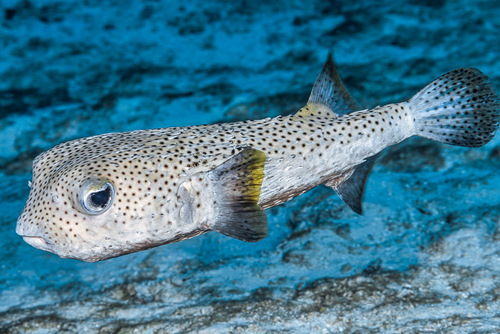
Porcupinefish
The Atlantic bluefin tuna (Thunnus thynnus) is a highly migratory species renowned for its size, speed, and strength. It's a top predator in the marine ecosystem and plays a critical role in maintaining the balance of ocean life. Highly prized for its meat, it is also one of the most commercially valuable fish.
5 10 years
Lifespan
91 cm
Length
Least Concern
Conservation Status
5 km/h
Swimming speed
Carnivorous
Diet
Local Migration
Migration
Appearance Overview
The Atlantic bluefin tuna is a large, torpedo-shaped fish with a metallic blue-black back and a silvery-white underside.
Coloration
Dark metallic blue on top with a silvery underside
Body Shape
Torpedo-shaped, streamlined body
Fins
Two dorsal fins, the first is depressible, and a series of finlets behind the second dorsal and anal fins
Length
Up to 13 feet (4 meters)
Weight
Up to 2,000 lbs (907 kg)
Diet
Carnivorous, feeding on fish, squid, crustaceans, and eel.
Feeding Behavior
Hunts by sight and is known for its incredible speed and agility, often hunting cooperatively to herd and capture prey.
Social Behavior
Forms large schools, particularly during spawning season, but can also be found in smaller groups or solitary.
Commercial Relevance
Extremely high value, particularly in sushi and sashimi markets, where its fatty flesh is considered a delicacy.
Conservation measures
Subject to international fishing quotas, stock assessments, and various management strategies aimed at rebuilding populations, including fishing restrictions and monitoring programs.
Status
Endangered (IUCN)
Threats
Overfishing, driven by high demand in international seafood markets, remains the primary threat. Also impacted by bycatch in fisheries targeting other species.
Habitat Distribution
Depth Range
0-3,300 feet (0-1,000 meters), though they are most commonly found in shallower waters.
Geographic Range
Western and Eastern Atlantic Ocean, including the Mediterranean Sea.
Preferred Environment
Pelagic, open ocean, but also found in coastal waters, exhibiting a wide temperature tolerance.
Reproduction and Life Cycle
Breeding Habits
Spawns in large aggregations primarily in the Mediterranean Sea and the Gulf of Mexico, with spawning occurring in warmer waters.
Development Stages
Eggs hatch into larvae which develop rapidly, feeding in plankton-rich waters. Juveniles grow quickly, eventually reaching immense sizes.
Fecundity
Highly fecund; a single female can produce up to 30 million eggs per spawning season.
Maturity Age
Reaches sexual maturity relatively late, around 4-8 years of age, depending on the population.
Faqs about Porcupinefish
Where are Atlantic bluefin tuna found?
Atlantic bluefin tuna are found across the Atlantic Ocean, from the eastern coast of North America to the Mediterranean Sea.
How long do Atlantic bluefin tuna live?
Their lifespan is estimated to be around 40 years.
Are Atlantic bluefin tuna warm-blooded?
Yes, they are warm-blooded, allowing them to maintain a body temperature higher than the surrounding water, which gives them advantages in speed and endurance.
How deep can Atlantic bluefin tuna dive?
They can dive to depths of over 3,000 feet (900 meters).
How fast can Atlantic Bluefin Tuna swim?
They are among the fastest fish in the ocean, capable of bursts of speed up to 43 mph (70 km/h).
Where do they breed?
Atlantic bluefin tuna primarily breed in the Mediterranean Sea and the Gulf of Mexico.
What is the main threat to the Atlantic bluefin tuna?
The main threat is commercial overfishing and being caught as bycatch.
Copyright @ Nature Style Limited. All Rights Reserved.
 English
English